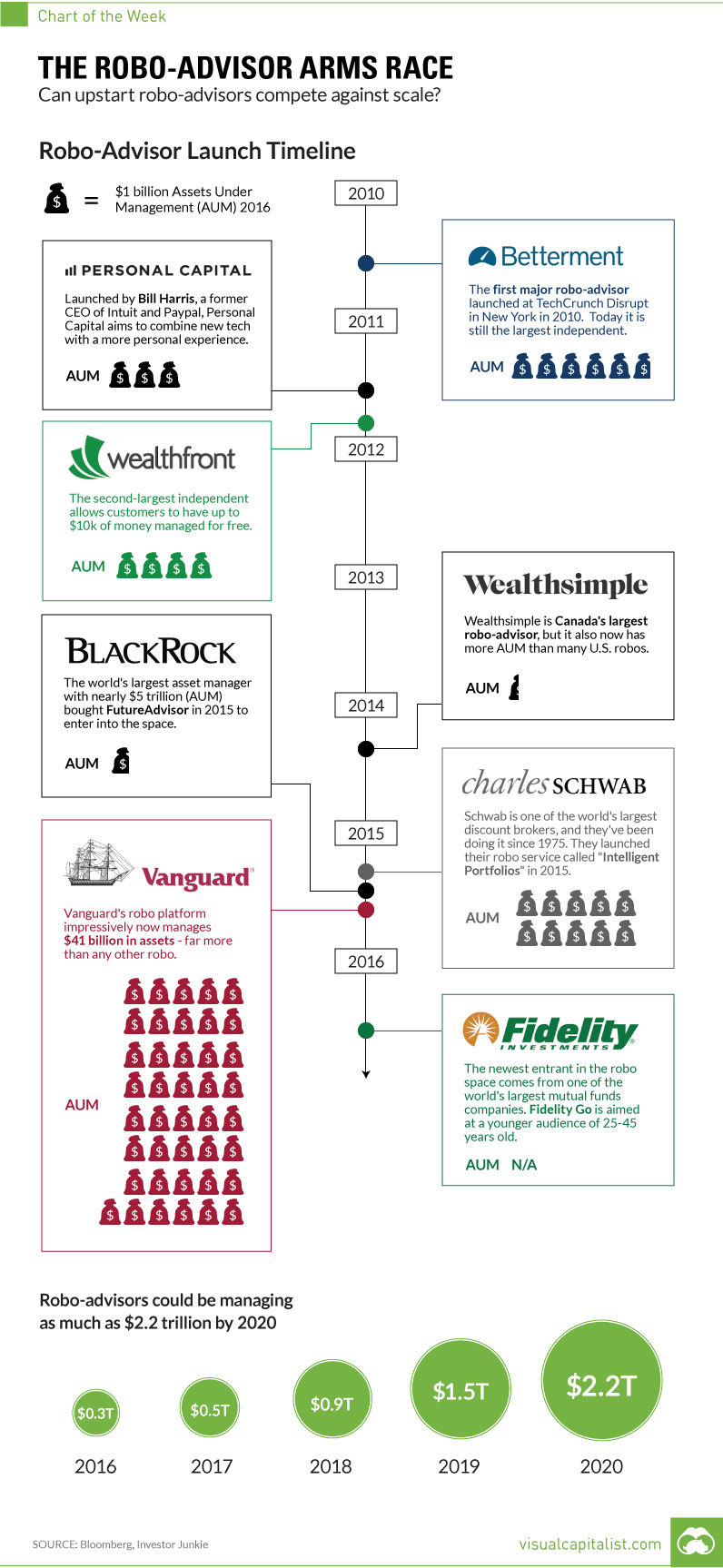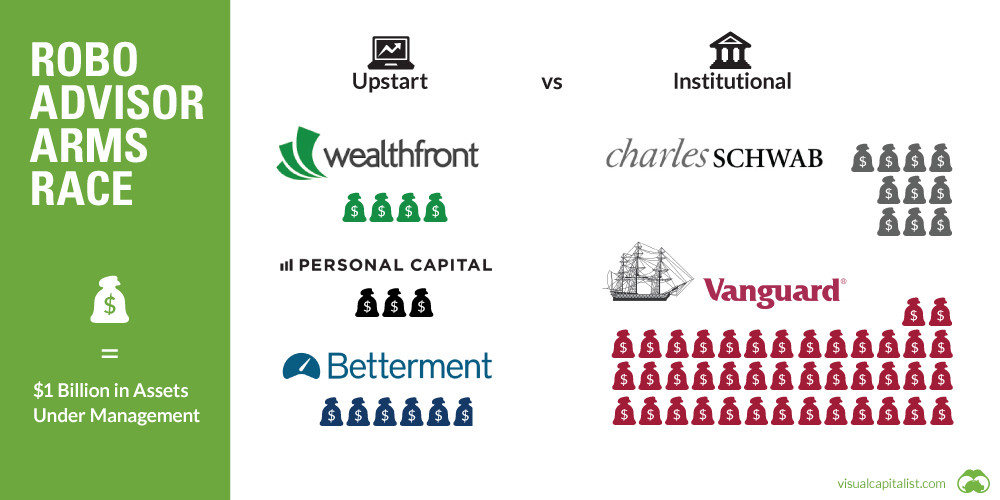The Robo-Advisor Arms Race
Can upstart robo-advisors compete against scale?
The Chart of the Week is a weekly Visual Capitalist feature on Fridays. It was going to happen sooner or later. When they launched roughly five years ago, tech-driven companies such as Betterment or Wealthfront had the audacious and laudable goal of taking on the incumbents of the gargantuan wealth management industry. Many traditional wealth managers were skeptical of portfolios being driven by artificial intelligence, and adopted a “wait and see” approach. If it became clear that the machines were indeed taking over the wealth management industry, they could then find some way to reverse-engineer their way into the market, using their scale and connections to make up ground. As the upstarts won new accounts and proved out the robo-advisor business model, the incumbents that dominate the traditional finance scene leaped into action. In 2015, behemoths like Vanguard and Charles Schwab, which each manage trillions of dollars of assets, fought back by introducing their own robo-advisor products. Meanwhile, Blackrock made an acquisition of an existing platform (FutureAdvisor) to enter the market, and just months ago mutual fund giant Fidelity launched its own robo-product called Fidelity Go. The scale of these companies meant that domination would become inevitable. Vanguard, for example, took its Personal Advisor Services platform from $0 in assets under management (AUM) last year to $41 billion today. By our math, that’s more than all other major U.S. robo-advisors combined. Charles Schwab, which has 9.3 million existing customers for its discount brokerage services, had no problem bringing customers over to its new platform. It also has $10 billion in AUM already in just a year, which is more than Betterment and Wealthfront combined. Spokespeople for the independent robo-advisors will tell you that they are building products for millennials, with an eye on a bigger prize. As wealth is transferred to the millennial generation over the coming years, they will be in position to take advantage of this as the brands that millennials trust. We are certain that these startups can evolve into great companies with this mission, but we also wonder if they ultimately left money on the table. Were they not aggressive enough? Could they have partnered with a bigger institution to roll out their product faster? Could they have gotten a bigger piece of the pie? It’s hard to say, but the robo-advisor space continues to be an interesting one to watch. It also teaches us an interesting lesson about trying to compete with mega-sized companies, which have scale, expertise, and resources at their disposal. on These are in the form of Treasury securities, some of the most liquid assets worldwide. Central banks use them for foreign exchange reserves and private investors flock to them during flights to safety thanks to their perceived low default risk. Beyond these reasons, foreign investors may buy Treasuries as a store of value. They are often used as collateral during certain international trade transactions, or countries can use them to help manage exchange rate policy. For example, countries may buy Treasuries to protect their currency’s exchange rate from speculation. In the above graphic, we show the foreign holders of the U.S. national debt using data from the U.S. Department of the Treasury.
Top Foreign Holders of U.S. Debt
With $1.1 trillion in Treasury holdings, Japan is the largest foreign holder of U.S. debt. Japan surpassed China as the top holder in 2019 as China shed over $250 billion, or 30% of its holdings in four years. This bond offloading by China is the one way the country can manage the yuan’s exchange rate. This is because if it sells dollars, it can buy the yuan when the currency falls. At the same time, China doesn’t solely use the dollar to manage its currency—it now uses a basket of currencies. Here are the countries that hold the most U.S. debt: As the above table shows, the United Kingdom is the third highest holder, at over $655 billion in Treasuries. Across Europe, 13 countries are notable holders of these securities, the highest in any region, followed by Asia-Pacific at 11 different holders. A handful of small nations own a surprising amount of U.S. debt. With a population of 70,000, the Cayman Islands own a towering amount of Treasury bonds to the tune of $284 billion. There are more hedge funds domiciled in the Cayman Islands per capita than any other nation worldwide. In fact, the four smallest nations in the visualization above—Cayman Islands, Bermuda, Bahamas, and Luxembourg—have a combined population of just 1.2 million people, but own a staggering $741 billion in Treasuries.
Interest Rates and Treasury Market Dynamics
Over 2022, foreign demand for Treasuries sank 6% as higher interest rates and a strong U.S. dollar made owning these bonds less profitable. This is because rising interest rates on U.S. debt makes the present value of their future income payments lower. Meanwhile, their prices also fall. As the chart below shows, this drop in demand is a sharp reversal from 2018-2020, when demand jumped as interest rates hovered at historic lows. A similar trend took place in the decade after the 2008-09 financial crisis when U.S. debt holdings effectively tripled from $2 to $6 trillion.
Driving this trend was China’s rapid purchase of Treasuries, which ballooned from $100 billion in 2002 to a peak of $1.3 trillion in 2013. As the country’s exports and output expanded, it sold yuan and bought dollars to help alleviate exchange rate pressure on its currency. Fast-forward to today, and global interest-rate uncertainty—which in turn can impact national currency valuations and therefore demand for Treasuries—continues to be a factor impacting the future direction of foreign U.S. debt holdings.

















